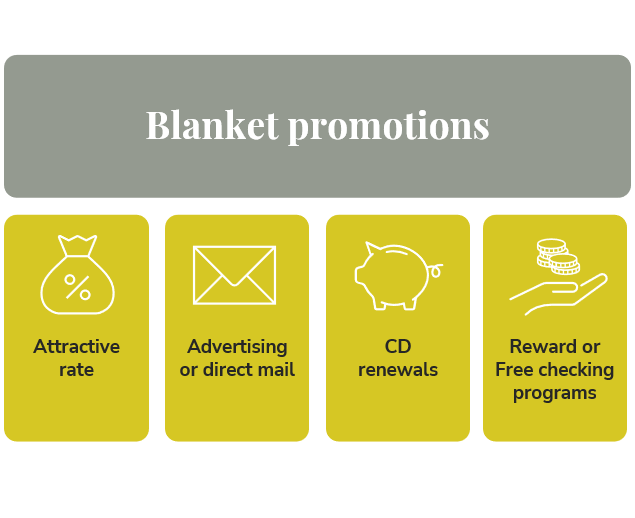Despite record deposit levels during the peak of the COVID-19 pandemic, deposits are increasingly a focus for our clients in 2023. In 2022 Q2, deposits held by Financial Institutions dropped for the first time since the beginning of the pandemic, and deposits dropped 1.1% in the third quarter. The decline in 2022 presents a potential funding strain for many financial institutions.
People have changed in recent years. Customers are feeling the pinch – they’re concerned about the economy, they want to save more money and they want more from the savings they have. Unsurprisingly, customers’ behaviors have also changed:
Only 4% of customers switched banks last year (J.D. Power, 2022)
35% of retail and 44% of business customers have second checking accounts (Cornerstone, 2021)
57% of core deposit accounts were opened via online or mobile banking in 2021.
Of the checking accounts opened in 2021, a very small percentage were opened with community banks (2.5%). According to FRB, 49% were opened with megabanks, 19% regional banks, 18.5% digital-only banks, and 7% with credit unions.
GROWING DEPOSITS – WHERE TO BEGIN?
If deposit growth is a strategic priority for your FI in 2023, you may be wondering where to start. Typically, current households account for 80% of the growth potential so looking at your customer base is a solid place to start.
On average, 47% of community FI households are single-service (Galapagos, 2022), and 35% of bank deposit customers have second accounts with other institutions. There’s room to expand these relationships to grow deposits and a clear campaign targeting customer wallet expansion works, delivering deposits and an ROI often above 5:1.
The benefits of targeting existing customers with product messaging are evident in the results for one Midwestern community bank. Galapagos developed a broad expansion calendar to promote consumer and business products and services to expand customer relationships. Communications were sent via email and direct mail throughout the year and generated Year One ROI for deposits of $1.33, and Lifetime of $3.20.
There are a variety of other approaches that can be used to drive growth. Traditional approaches include promoting an attractive rate, CD renewals, and Reward/Free Checking Programs. There are pros and cons to these approaches, including cannibalization of low-cost deposits, unnecessary re-pricing, and poor-quality deposits.
While rate promotions can be used successfully to raise deposits in a shorter timeframe, the accounts acquired rarely stay with the FI long term and because most of these customers are rate shoppers, they are not inclined to develop broader relationships. Galapagos prefers a strategic approach to determine the best way to grow, that is sustainable over time and provides opportunities to develop new, deeper relationships with customers. The process identifies the needs of the customers and takes a deep dive into the data. The analysis ranks every customer household on its propensity to use each product offering and which combination of variables can predict usage. Targeted communications, together with a sales focus, are deployed in an integrated approach to customers fitting the propensity profiles.
A $340 million community bank recently implemented this approach to drive deposit growth with an emphasis on checking. Propensity profiles were developed for both current customers and prospects and integrated communications were crafted to engage targets with optimal frequency. Communications drove people to a custom landing page and online account application. The branches supplemented these efforts with outreach with lists provided. Nearly 25,000 pieces of mail were dropped, generating 391 responses, a Year 1 ROI of $3.31, and a Lifetime ROI of $6.45. The campaign generated target balances of $2,441,012 and cross-sold balances of $10,182,324.
There are a variety of proven approaches to capturing deposits and your approach needs to be tailored to your circumstances. As you evaluate your options, you will want to take into account the extent and urgency of need, composition of your customer base, extent and composition of market opportunity, and internal resources. Careful assessment of these factors will deliver the optimal approach.
Unsure where to start? Give us a call today to set up an appointment to talk about your deposit goals.

